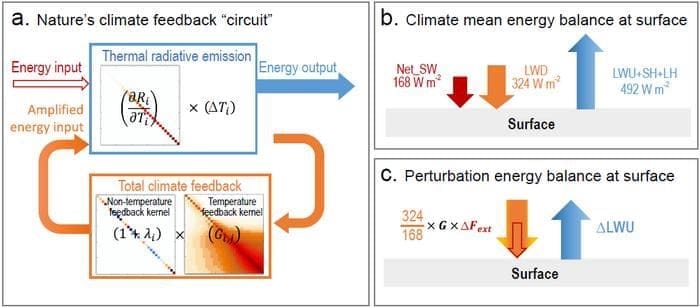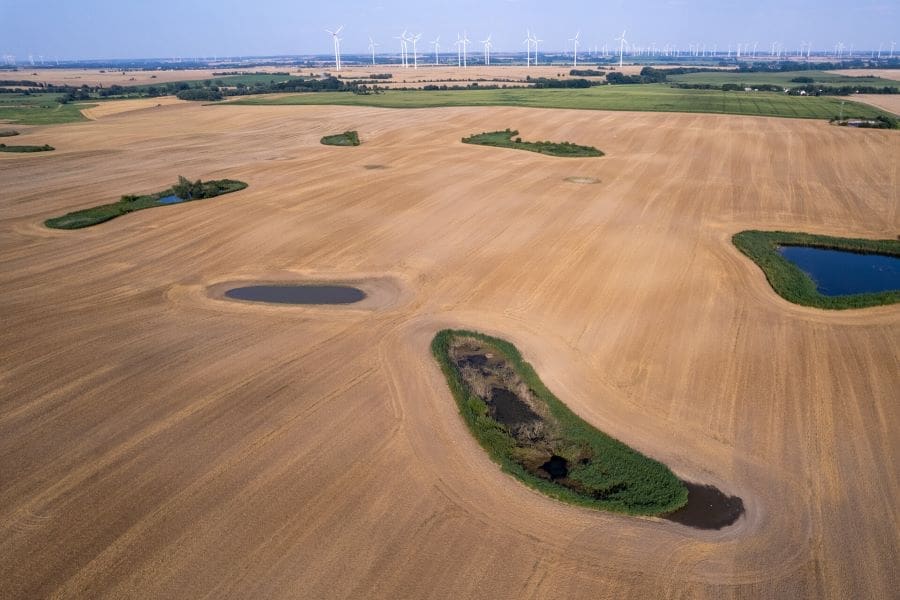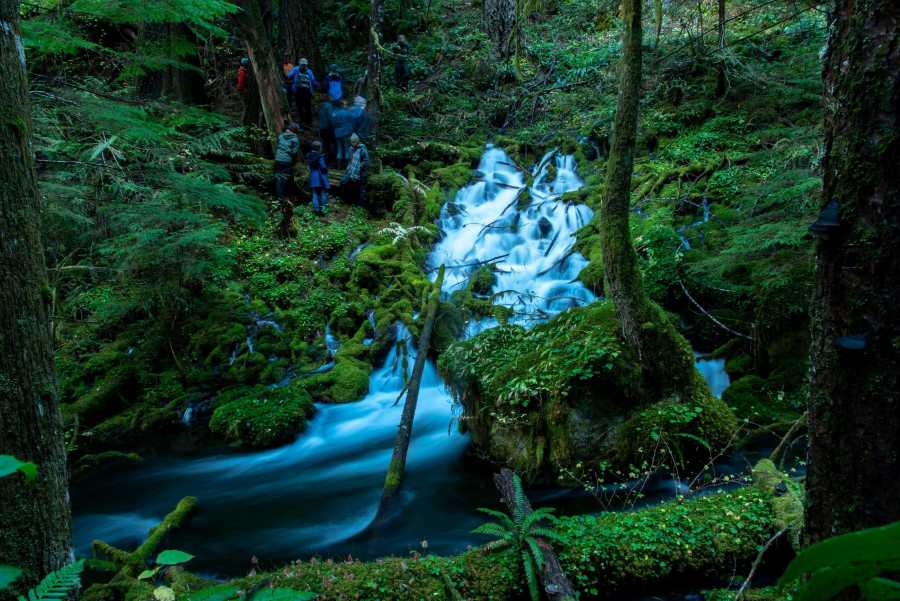Table of Contents
New framework predicts global warming driven by greenhouse gases
Science China Press – A research team led by Professor Ming Cai from Florida State University, in collaboration with researchers from Sun Yat-sen University, Peking University, and the Massachusetts Institute of Technology, recently published a groundbreaking paper in National Science Review.
Titled ‘Principles-Based Adept Predictions of Global Warming from Climate Mean States’, the study introduces a novel framework that accurately predicts the magnitude and spatial pattern of global warming caused by greenhouse gas emissions, without relying on complex climate models or statistical analysis. For the first time, this study confirms that observed global warming is driven by human-caused greenhouse gas emissions, independently of these conventional approaches.

This new framework incorporates energy balance principles and the coupled atmosphere-surface thermal absorption and emission processes, modeled similarly to feedback loops in electrical circuits. It directly quantifies the amplification of external energy inputs through climate feedback processes, using the information from climate mean states.
Unlike climate models, this approach bypasses the need for costly time integrations to equilibrium and instead directly and efficiently calculates the equilibrium response of the global climate system to external energy perturbations.
The observed global mean warming from 1980–2000 to 2000–2020 is 0.414 K, while the framework predicts a warming of 0.403 K based solely on observed CO2 concentration changes, excluding natural climate variability and aerosols. In comparison, climate simulations by CMIP6 models overestimate the observed warming by 50%.
Additionally, the new framework’s predictions have a smaller global mean absolute error compared to CMIP6 models. This study also tested the framework under two assumed CO2 scenarios: a sudden quadrupling of CO2 and a 1% annual increase in CO2.
The framework accurately reproduced the global warming projections for each of these scenarios from CMIP6 models, with smaller uncertainty in warming predictions compared to the models. These results highlight the new framework’s reliability and broad applicability.
Journal Reference:
Ming Cai, Xiaoming Hu, Jie Sun, Yongyun Hu, Guosheng Liu, Zhaohua Wu, Feng Ding, Wanying Kang, ‘Principles-Based adept predictions of global warming from climate mean states’, National Science Review nwae442 (2024). DOI: 10.1093/nsr/nwae442
Article Source:
Press Release/Material by Science China Press
Wind turbines impair the access of bats to water bodies in agricultural landscapes
Leibniz-IZW – Bats depend on open bodies of water such as small ponds and lakes for foraging and drinking. Access to water is particularly important for survival in the increasingly hot and dry summers caused by climate change, the time when female bats are pregnant and rear their young.
A scientific team from the Leibniz Institute for Zoo and Wildlife Research (Leibniz-IZW) has now shown that access to drinking sites is hampered by wind turbines in agricultural landscapes: Many bat species avoid the turbines and water bodies located close to the turbines for several kilometres.
These results have been published in the scientific journal Biological Conservation.
In order to counteract climate change, many countries are investing in the expansion of wind energy production in order to reduce greenhouse gases such as CO2 through renewable electricity. However, the expansion of wind power production may also have negative consequences for wildlife and their habitats. This can potentially lead to some wildlife species being less able to cope with global warming.
Prof Dr Christian Voigt and Dr Carolin Scholz from the Leibniz-IZW and Hannah Klein from the University of Potsdam showed in a scientific investigation of the acoustic activity of bats in agricultural landscapes that many bat species are displaced by wind turbines near smaller bodies of water.
They analysed the spatial behaviour of bats belonging to the three functional guilds of open space foraging bats (that hunt above fields or the canopy of forests), narrow space foraging bats (that hunt in dense vegetations, for example below the forest canopy) and edge space foraging bats (that are specialised in foraging in transition zones such as forest edges).

“We were able to clearly recognise that those bats which specialized to forage in the open space and in dense vegetation avoided water bodies when wind turbines were located near them,” says Voigt. “Only species of the guild of edge space foraging bats are apparently not driven away from the water sites by the wind turbines.”
The scientists placed acoustic detectors at a total of 59 small ponds that are permanently filled with water at distances of around 50 to 5,000 metres from wind turbines in northern Brandenburg, a federal state in Eastern Germany. Owing to its glacial history, the study area has more than a thousand of these small ponds, called kettle holes, kettle lakes or pothole lakes, which fulfil important ecological functions even in the intensively used agricultural landscape.
“During the reproductive season in July, we measured the acoustic activity of bats at bodies of water at different distances from wind turbines. We paid attention to compare the data for similar conditions, such as a lack of rain and moderate winds,” explains Scholz. “In July, the lactation period of female bats slowly comes to an end and the young are weaned from the nursery roosts, which is an energetically strenuous phase for female bats. In addition, many waterholes dry up in midsummer, which is why the bats may be more dependent on small bodies of water that contain water all year round.”
The team identified a total of almost 8,400 calls of different bat species in the three bat guilds of open space hunters, narrow space hunters and edge spacer foragers. “With increasing proximity to wind turbines, the activity of open space foraging bats at water bodies decreased by 53 percent and the activity of bat species adapted to hunting in narrow vegetation decreased by 63 percent,” the authors summarise.
The same picture was revealed when analysing the foraging behaviour that can be identified by the acoustic detectors: It decreased by 87 and 76 percent respectively as the distance to a wind turbine decreased from 5 kilometres to virtually zero.
“There is a certain tragedy in these results, because a measure to mitigate climate change has the unfortunate side effect that certain bats are less able to cope with hot and dry summers if they are displaced from their habitats by wind turbines,” says Voigt. “This emphasises once again how important it is to carefully consider the siting of wind turbines so as not to play off different objectives against each other. Habitats that are very important for species conservation should be given low priority or entirely excluded as sites for wind energy production.”
The bat species studied include the common pipistrelle (Pipistrellus pipistrellus), the soprano pipistrelle (Pipistrellus pygmaeus) and the western barbastelle (Barbastella barbastellus) as representatives of edge space foraging bats, species of the genera noctule bats (Nyctalus), house bats (Eptesicus) and vesper bats (Vespertilio) as representatives of open space foraging bats, and species of the genus mouse-eared bats (Myotis) and long-eared bats (Plecotus) as representatives of narrow space foraging bats.
Bats are protected species under German nature conservation law and EU law and should also be specially protected as migratory species. This protection is conflicting with the expansion of wind energy production, because there are a significant number of direct fatalities at the turbines and the habitats of bats are impaired in many ways.
Voigt’s team at the IZW has been conducting research into this ‘green-green conflict’ between wind power expansion and bat conservation for many years.
Journal Reference:
Carolin Scholz, Hannah Klein, Christian C. Voigt, ‘Wind turbines displace bats from drinking sites’, Biological Conservation 302, 110968 (2025). DOI: 10.1016/j.biocon.2025.110968
Article Source:
Press Release/Material by Leibniz Institute for Zoo and Wildlife Research (IZW)
Hidden aquifer discovered beneath the Oregon Cascades
University of Oregon – Oregon’s Cascade Range mountains might not hold gold, but they store another precious resource in abundance: water.
Scientists from the University of Oregon and their partners have mapped the amount of water stored beneath volcanic rocks at the crest of the central Oregon Cascades and found an aquifer many times larger than previously estimated — at least 81 cubic kilometers.
That’s almost three times the maximum capacity of Lake Mead, the currently overdrawn reservoir along the Colorado River that supplies water to California, Arizona and Nevada, and greater than half the volume of Lake Tahoe.

The finding has implications for the way scientists and policymakers think about water in the region — an increasingly urgent issue across the Western United States as climate change reduces snowpack, intensifies drought and strains limited resources.
It also shapes our understanding of volcanic hazards in the area. Magma interacting with lots of water often leads to explosive eruptions that blast ash and gas into the air, rather than eruptions with slower-moving lava flows.
“It is a continental-size lake stored in the rocks at the top of the mountains, like a big water tower,” said Leif Karlstrom, a UO earth scientist who led the study alongside collaborators from Oregon State University, Fort Lewis College, Duke University, the University of Wisconsin, the U.S. Forest Service and the U.S. Geological Survey.
“That there are similar large volcanic aquifers north of the Columbia Gorge and near Mount Shasta likely make the Cascade Range the largest aquifer of its kind in the world.”
The team reported the findings in a paper published in the journal Proceedings of the National Academy of Sciences.
Most Oregonians rely on water that originates from the Cascades. For example, the McKenzie River, which supplies most of Eugene’s drinking water, begins high in the mountains at the spring-fed Clear Lake. But the discovery of this underground aquifer’s size was a surprise.
“We initially set out to better understand how the Cascade landscape has evolved over time, and how water moves through it,” said study co-author Gordon Grant, a geologist with the Forest Service. “But in conducting this basic research, we discovered important things that people care about: the incredible volume of water in active storage in the Cascades and also how the movement of water and the hazards posed by volcanoes are linked together.”
The western Cascades are characterized by steep slopes and deep valleys carved out by rivers. The high Cascades, meanwhile, are flatter, dotted with lakes and volcanic topography such as lava flows. The Cascade Range has been built up by volcanic activity over millions of years, making the exposed rocks in the high Cascades much younger than those in the western Cascades.
As a result, the transition zone between the western Cascades and the high Cascades around Santiam Pass is a natural laboratory for understanding how volcanoes have shaped Oregon’s landscape.
“What motivates our work is that it’s not just how these landscapes look different topographically. It’s that water moves through them in really different ways,” Karlstrom said.
To better understand the flow of water through different volcanic zones, the team took advantage of projects begun in the 1980s and 90s. Past scientists had drilled deep into the ground and measured temperatures at different depths as part of the search for geothermal energy resources associated with the many hot springs that pepper the Cascades landscape.
Normally, rocks get hotter as you go deeper into the earth. But water percolating downward disrupts the temperature gradient, making rocks a kilometer deep the same temperature as rocks at the surface.
By analyzing where the temperature starts to pick up again in these deep drill holes, Karlstrom and his colleagues could infer how deeply groundwater was infiltrating through cracks in the volcanic rocks. That allowed them to map the volume of the aquifer.
Previous estimates of water availability in the Cascades took the springs at face value, measuring river and stream discharge. Instead, Karlstrom and his colleagues went deeper — literally. But since those holes weren’t originally drilled with the intent of mapping groundwater, they don’t cover every area where one might like to collect such data. So the new estimate of the size of the aquifer is a lower bound, and the actual volume might be even bigger still.
While it’s encouraging news that the aquifer is so much larger than previously believed, Karlstrom cautions that it’s still a limited resource that must be carefully stewarded and needs further study.
“It is a big, active groundwater reservoir up there right now, but its longevity and resilience to change is set by the availability of recharging waters,” he said.
The aquifer is largely replenished by snow, and snowpack in the high Cascades is expected to rapidly decrease in the coming decades. More precipitation is expected to fall as rain, which may impact the amount of recharge feeding the high Cascade aquifer. And while it’s likely resilient to small year-to-year fluctuations, many years in a row of low rainfall or no snowpack would probably be a different story.
“This region has been handed a geological gift, but we really are only beginning to understand it,” Grant said. “If we don’t have any snow, or if we have a run of bad winters where we don’t get any rain, what’s that going to mean? Those are the key questions we’re now having to focus on.”
Journal Reference:
L. Karlstrom, N. Klema, G.E. Grant, C. Finn, P.L. Sullivan, S. Cooley, A. Simpson, B. Fasth, K. Cashman, K. Ferrier, L. Ball, D. McKay, ‘State shifts in the deep Critical Zone drive landscape evolution in volcanic terrains’, Proceedings of the National Academy of Sciences 122 (3): e2415155122 (2025). DOI: 10.1073/pnas.2415155122
Article Source:
Press Release/Material by Laurel Hamers | University of Oregon
New study links home temperature to cognitive function in older adults
Hebrew SeniorLife Hinda / Arthur Marcus Institute for Aging Research – A groundbreaking study has identified a significant relationship between indoor temperatures and cognitive performance in older adults, shedding light on how climate change may pose an increased risk to cognitive health.
Conducted by scientists at the Hinda and Arthur Marcus Institute for Aging Research, the research arm of Hebrew SeniorLife, a nonprofit affiliate of Harvard Medical School, the study found that older adults reported the least difficulty maintaining attention when their home temperatures were within 68–75 ˚F (20–24 ˚C). Outside of this range, the likelihood of attention difficulties doubled with a 7 ˚F (4 ˚C) variation in either direction.
The longitudinal observational study monitored home temperatures and self-reported attention difficulties in 47 adults aged 65 and older over the course of a year.
The findings, published in the Journal of Gerontology: Series A, suggest that even current climate conditions are placing older adults at risk, with many experiencing indoor temperatures that may impair their cognitive abilities. The implications are particularly concerning for low-income and underserved populations, who may have fewer resources to regulate their home environments.
“Our findings underscore the importance of understanding how environmental factors, like indoor temperature, impact cognitive health in aging populations,” said Amir Baniassadi, PhD, lead author of the study, an Assistant Scientist II at the Marcus Institute and a leading expert in the study of the effects of climate change on seniors.
“This research highlights the need for public health interventions and housing policies that prioritize climate resilience for older adults. As global temperatures rise, ensuring access to temperature-controlled environments will be crucial for protecting their cognitive well-being.”
Following a 2023 study measuring how temperature affected how older adults slept and their cognitive ability, the study currently adds to growing evidence that the effects of climate change extend beyond physical health to encompass cognitive functioning, emphasizing the need for proactive measures.
Potential solutions include integrating smart home technologies to optimize indoor temperatures, improving energy efficiency in housing, and expanding access to cooling resources.
Other researchers on the study, who all work at the Marcus Institute, included Wanting Yu, BSc, Project Director I; Thomas Travison, PhD, Senior Scientist; Ryan Day; Lewis Lipsitz, MD, Director, Marcus Institute and Chief Academic Officer, Irving and Edyth S. Usen and Family Chair in Medical Research, Hebrew SeniorLife; and Brad Manor, PhD, associate scientist.
Journal Reference:
Amir Baniassadi, Wanting Yu, Thomas Travison, Ryan Day, Lewis Lipsitz, Brad Manor, ‘Home Ambient Temperature and Self-reported Attention in Community-Dwelling Older Adults’, The Journals of Gerontology: Series A glae286 (2024). DOI: 10.1093/gerona/glae286
Article Source:
Press Release/Material by Hebrew SeniorLife Hinda / Arthur Marcus Institute for Aging Research
Featured image credit: Gerd Altmann | Pixabay




